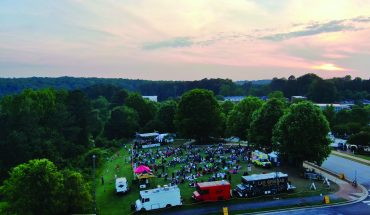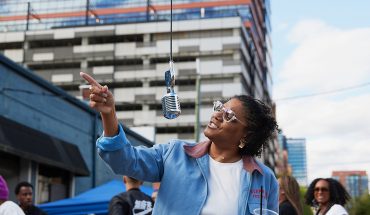text and photo by Scott Huler
Do you ever get the desire, now and again, to sneak off, to slip away somewhere clandestine? Don’t you want to go down a back alley? An alley: an atmospheric cave of brick and concrete, populated by fire escapes and dumpsters. An interstitial space, neither here nor there, neither street nor yard, public nor private. A world of its own awaiting exploration, an alley is the adult version of the childhood crawlspace hideyhole, the adolescent exploration of steam tunnels or storm sewers.
Except: bad news. Raleigh has lots of wonderful things, but it almost totally lacks alleys.
Urban ones, anyway. Look at any map. Raleigh has been a city of broad streets and private yards since its planning in 1792, and here in the mostly rural South, we never had the early 20th-century development explosion that made downtown land expensive and alleys necessary. Even what might be our downtown alleys – One Exchange Plaza and Market Square Plaza, off Fayetteville Street – have become little parks, already slated for redevelopment, no less.
In fact, though, Raleigh does have alleys: You just have to know where to look. Not your big-city, urban alleys, mind you – they’re Southern alleys. Green alleys. Raleigh alleys. They abound in the Cameron Park neighborhood, built in the early 20th century north of Hillsborough and west of St. Mary’s. Designed exclusively for upscale – and white – Raleighites, those homes needed back entries for carriages and motorcars (and the help who would not be welcome to come in the front). Many of these alleys remain, and they remain public. You can still find them bisecting blocks throughout that neighborhood, and in Boylan Heights and Glenwood/Brooklyn, too. They’re fun to creep down, though despite their public status they even now can foster a feeling of transgression. They’re not really shortcuts from anywhere to anywhere, and you peer into people’s backyards and back windows. Which is fun, but not always perfectly comfortable.
But surely the most accessible of Raleigh’s alleys is one with a less-nefarious past – and an actual street sign: Horse Track Alley, which runs south from Clark Avenue down to College Crest. College Crest is itself an alley, which runs behind Mitch’s Tavern and the shops on the 2400 block of Hillsborough Street. College Crest Alley feels like what it is – broad parking lots and asphalt. But look north, up Horse Track, and you’re transported.
If an urban alley resonates with childhood play in buildings and infrastructure, an alley like Horse Track resonates with pathways behind the garage and through the hedge. Horse Track goes, in fact, behind the garages of apartment houses on Horne and Chamberlain streets. Cracked asphalt, going to gravel on the edges as bamboo and grasses patiently dismantle the pavement; the gaping mouths of barely maintained garages; garbage and recycling bins; and the rolled and forgotten carpets, abandoned desks, and half-filled, rain-soaked boxes that identify the habitat of college students. No-parking signs of all indigenous towing services. Fences of many varieties – chain link, chicken wire, wooden stockade.
Horse Track Alley actually did once run along a horse track – when the State Fairgrounds stood at their second location, Horne was their eastern boundary, so the alley along its back fence took the name of the fairgrounds track. But that’s almost a century ago now. Mature sassafras, willow oaks, and maples now arch over the alley, providing dappled shade the birds love. The only thing missing from Horse Track Alley now is a horse.
It’s not a park, but it’s not a street, either. And it’s not someone’s yard, but it’s not quite public. It’s somewhere in between. It’s an alley.
Meet you there.




